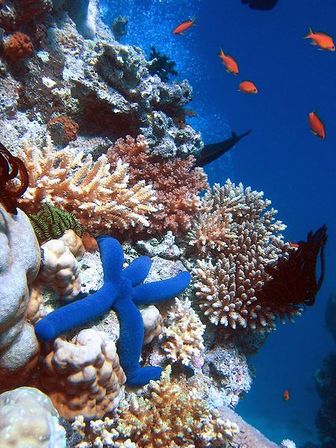Coral reef

Picture has been licensed under a GFDL
Original source: Own work
Author: Richard Ling
Permission: GNU Free Documentation License
Original source: Own work
Author: Richard Ling
Permission: GNU Free Documentation License
Facts about Coral reef
Send your friends a coral reef E-Card to show them what's at stake and
to get them involved.
Some of the biodiversity of a coral reef, in this case the Great
Barrier Reef, Australia.
Coral reefs are aragonite structures produced by living organisms,
found in shallow, tropical marine waters with little to no nutrients
in the water.
The United States Coral Reef Task Force (USCRTF) was established in
1998 by Presidential Executive Order to lead U.S. efforts to preserve
and protect coral reef ecosystems. The USCRTF includes leaders of 12
Federal agencies, seven U.S. States, Territories, Commonwealths, and
three Freely Associated States.
Most coral reefs are built
from stony corals, and are formed by polyps that live together in
groups. The polyps secrete a hard carbonate exoskeleton which provides
support and protection for the body of each polyp.
Coral reef fish are fish which live amongst or in close relation to
coral reefs. Coral reefs form complex ecosystems with tremendous
biodiversity. Among the myriad inhabitants, the fish stand out as
particularly colourful and interesting to watch.
LOCATION: Coral reefs are generally found in clear, tropical oceans.
Coral reefs form in waters from the surface to about 150 feet deep
because they need sunlight to survive. The three types of reefs
include fringing reefs, barrier reefs, and atolls.
Many coral reefs are hundreds of metres deep
and yet corals will not grow at depths of more than 30-40 m. It has
been suggested that deep reefs have formed during a long period of
subsidence. Thus, coral forms in shallow waters and then sinks.
Coral Reefs: Issues of Importance
CORALS: AN OVERVIEW
Scientists divide natural objects and living things into several
categories—animals, plants, fungi, bacteria, and protists.
Aerial image of oil slick moving towards coral reef (from 1986 spill at Bahia las Minas refinery in Panama).
A coral reef is produced only if the coral
reef community produces more calcium carbonate than is removed.
Indeed, some coral reef communities grow too slowly to build a reef.
* Coral Reefs Ecosystems Essays
* Navassa
* Northwestern Hawaiian Islands
* U.S.
Coral reefs are fragile, highly complex communities which have great
biological and habitat diversity.
Distribution of the world's coral reefs, showing the relationship to average temperature of the ocean surface.Distribution
of the world's coral reefs, showing the relationship to average
temperature of the ocean surface.
Estuaries > Habitat Protection > Coral Reef Protection
End Hierarchical Links
Habitat Protection HomeCoral ReefsRestoration ActMarine DebrisHabitat
Protection
and Restoration
OverviewNational Program
ResultsWhat You Can DoOceans and Coasts
for Children,
Students
coral reef systems in certain parts of the world. Although coral reef
ecosystems have long proven their resiliency to natural stressors,
many of these unique ecosystems are under an increasing amount of
pressure from anthropogenic, or human induced, influences.
Some of the biodiversity of a coral reef, in this case the Great
Barrier Reef, Australia.
Coral Reefs, Explore the coral reefs of the Tropics
=
Help us protect coral reefs in Indonesia and coral reefs around the world
If the present rate of destruction continues, 70% of the world's coral
reefs will be destroyed by the year 2050.
Coral Reefs are the "Rainforests" of the ocean. Reefs are ecologically
important ecosystems and have a high biodiversity that serves as a
storage bank of rich genetic resources. They are a source of food and
medicine, and they protect the coast from wave erosion.
